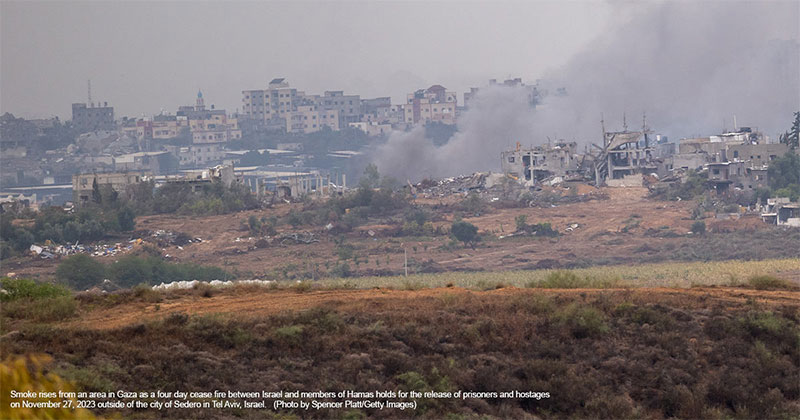
Israel and Hamas agreed to a four-day ceasefire which began Friday, during which Israel has agreed to release three Palestinian prisoners for every Israeli hostage freed. As of early Monday morning, Islamist terrorists based in Gaza had released 58 hostages, including 39 Israelis, while Israel had freed 117 Palestinians. Despite alleged and real violations of the ceasefire, the combatants agreed Monday to extend the ceasefire for two more days.
Calls for a pause in fighting began immediately after Hamas terrorists invaded Israel on October 7, killing more than 1,200 Israelis, wounding more than 5,000, and kidnapping more than 240 hostages. Hamas militants directly targeted civilians, including elderly women, children, and even babies; they burned, raped, murdered, and committed unspeakable acts of brutality. In context, early calls for a ceasefire — after Hamas finished shooting but before Israel began — implicitly denied that Israel had a right to defend itself, and therefore a right to exist as a sovereign nation.
Demands for a ceasefire intensified as Israel’s air force bombed military targets and Hamas looted humanitarian stores throughout Gaza. On October 27, a majority of world governments passed a resolution of the U.N. General Assembly that called for an “immediate” truce in Gaza and contained no condemnation of Hamas. On November 1, the anti-Semitic wing of the Democratic Party pressured President Biden to reverse his rhetorical support for Israel and add his voice to the growing chorus chanting, “ceasefire now!” On November 9, Israel agreed to observe four-hour daily pauses to allow civilians to evacuate.
“Just as the United States would not agree to a ceasefire after the bombing of Pearl Harbor, or after the terrorist attack of 9/11, Israel will not agree to a cessation of hostilities with Hamas,” Israeli Prime Minister Benjamin Netanyahu said in response to global pressure for Israel to unilaterally lay down its arms.
Circumstances changed early last week when Israeli Defense Forces (IDF) successfully completed a two-front pincer advance on Al-Shifa hospital complex in northwest Gaza, which they have long identified as sitting above a key node of Hamas operations. The IDF has produced surveillance footage showing Hamas dragging two hostages through Al-Shifa hospital on October 7, as well as stolen IDF vehicles brought to the center. Israel believes that one hostage, Corporal Noa Marciano, was murdered in the hospital before her body was later found several blocks away. They also found a weapons laboratory in the basement containing finished and half-finished mortars, warheads, thermobaric weapons, and RPGs.
The IDF has also made efforts to explore the web of tunnels underneath Al-Shifa. On Wednesday, they showed journalists a tunnel stretching for 55 meters, which led to a restroom, kitchen, a large room with air conditioning, and several smaller rooms before ending in a blast-proof door with loopholes that would allow Hamas fighters to defend it against the IDF. The IDF also found dozens of guns, ammunition clips, and grenades in the tunnel.
“The findings prove beyond all doubt that buildings in the hospital complex are used as infrastructure for the Hamas terror organization, for terror activity,” the IDF said. “This is further proof of the cynical use that the Hamas terror organization makes of the residents of the Gaza Strip as a human shield for its murderous terror activities.”
It’s unclear whether Israel has completely explored Hamas’s tunnel network under Al-Shifa. The aforementioned tunnel’s only entrance was a four-foot-square hole in the ground, which the IDF only discovered by accident. This raises the possibility that similar underground features are similarly well-concealed. IDF forces exploring other tunnel corridors have found at least one exit leading to a kindergarten and another tunnel underneath a mosque. “It’s going to take time” for Israel to unearth all Hamas hideouts under the 10-acre hospital complex, said Lieutenant Colonel Richard Hecht.
However, Israel’s capture of Hamas’s chief military post did give it an opportunity to contemplate a ceasefire. Israel’s two objectives are freeing the hostages and exterminating Hamas from Gaza. Unfortunately, the IDF did not manage to free any more hostages during their advance on Al-Shifa. The painstaking measures it adopts to protect civilians necessarily slow down its movements, enabling Hamas to spirit away its captives before Israeli rescuers can arrive. Israel is still committed to destroying Hamas, but it agreed to a ceasefire to negotiate the release of as many hostages as possible.
Before the ceasefire took effect, Israel demolished tunnels located beneath Al-Shifa and redeployed troops to the ceasefire lines.
The four-day ceasefire went into effect on Friday at 7 a.m. local time. On Friday, Hamas released 24 hostages — 13 Israeli women and children, 10 Thai citizens, and a Filipino citizen — and Israel reciprocated by releasing 39 imprisoned Palestinians. On Saturday, after a delay, Hamas released 17 hostages — 13 Israelis and four Thai nationals — and Israel released another 39 Palestinians. On Sunday, Hamas released another 17 hostages — 13 Israelis, three Thai nationals, and a dual Israeli-American citizen (a four-year-old girl whose parents Hamas killed on October 7) — and Israel released another 39 Palestinians. All told, Hamas has released 39 Israelis, 17 Thai citizens, one Filipino citizen, and one dual Israeli-American citizen, while Israel has released 117 Palestinian prisoners.
As of Monday afternoon, a fourth prisoner exchange had begun, with Hamas reportedly releasing 11 Israelis in exchange for the release of 33 Palestinian prisoners.
Thus far, all the prisoners exchanged between Hamas and Israel have been women and children. Many of the Palestinian prisoners released by Israel are teenage boys from the West Bank convicted of security offenses such as stone-throwing or disturbing the public order.
The Thai and Filipino hostages were not part of the Israel-Hamas ceasefire, brokered by the U.S., Qatar, and Egypt but were apparently released in a separate deal the Kingdom of Thailand brokered with Iran.
With the release of more hostages, the world learns more about the conditions they faced. “Their captivity sounds horrific — held underground for seven weeks, barely fed, sleeping on chairs, and denied the ability to go to the bathroom for hours; some in need of medical care, including one elderly woman in life-threatening condition,” summarized National Review’s Jim Geraghty.
On Monday afternoon, Qatari Foreign Ministry spokesman Majid Al Ansary announced that Israel and Hamas had agreed to extend the truce for two more days, allowing for the release of another 20 hostages. This agreement would extend the ceasefire until 7 a.m. local time on Thursday.
However, the preservation of the ceasefire is not automatically guaranteed. Unspecified Palestinian militants broke the ceasefire after only 15 minutes when they fired a rocket towards southern Israel — fortunately, it did no damage. “The world barely noticed; no one really expects Hamas to uphold its end of the agreement,” interpreted Geraghty. Hamas has also separated family units, in violation of the ceasefire.
For their part, Hamas officials have complained that Israel violated the terms of the ceasefire by not allowing humanitarian aid trucks into Gaza (Israel allowed 200 trucks carrying aid to enter), not releasing prisoners in the order Hamas wanted (Israel never promised to do so), and firing at Gazans seeking to return to northern Gaza (the ceasefire forbids reentry).
Hamas broke the last ceasefire on October 7 when, after years of lulling the IDF into a false sense of security, it launched a murderous surprise attack on the holiest day in the Jewish calendar. Still smarting from the latest blow, Israel is in no mood to trust the untrustworthy Hamas to abide by another ceasefire.
Whether the ceasefire continues for two days only or extends much longer, there is little hope of a permanent peace between Hamas and Israel. The Iranian-backed terrorist group has stated repeatedly and publicly that it aims at the total “annihilation” of Israel. Faced with an existential threat, Israel has no choice but to make its war aim to “destroy Hamas” — at least in Gaza. Thus, Israel is prepared to resume military operations in “full force” as soon as the ceasefire ends — assuming Hamas waits that long.

















